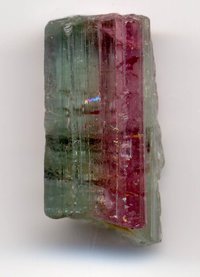Tourmaline
|
|
| Tourmaline | |
|---|---|
Missing image TourmalineUSGOV.jpg Tourmaline | |
| General | |
| Category | Mineral |
| Chemical formula | Na(Al,Fe,Li,Mg,Mn)M3Al(Si6O18)(BO3)3.(OH,F)4 |
| Identification | |
| Color | Mainly black, but can range from brown, violet, green, pink, or in a dual-colored pink and green. |
| Crystal habit | Parallel and elongated. Acircular prisms, sometimes radiating. Massive. Scattered grains (in granite). |
| Crystal system | Trigonal |
| Cleavage | Good to poor prismatic. Poor rhombohedral |
| Fracture | Subconchoidal to even |
| Mohs Scale hardness | 7 - 7.5 |
| Luster | Vitreous, sometimes resinous |
| Refractive index | nω=1.635 - 1.675 nε=1.610 - 1.650 |
| Pleochroism | None |
| Streak | Colorless |
| Specific gravity | 3.02 - 3.26 |
| Fusibility | ? |
| Solubility | ? |
| Major varieties | |
| Dravite | Brownish |
| Rubellite | Pink |
| Indicolite | Dark blue |
| Schorl | Black |
The mineral tourmaline is chemically one of the most complicated silicate minerals. It is a complex silicate of aluminium and boron but because of isomorphous replacement (solid solution) its composition varies widely with iron, magnesium and lithium and other elements entering into the combination to a greater or lesser extent.
Tourmaline belongs to the trigonal crystal system and occurs as long, slender to thick prismatic and columnar crystals that are usually triangular in cross-section. Interestingly the style of termination at the ends of crystals is asymmetrical, called hemimorphism. Small slender prismatic crystals are common in a fine grained granite called aplite often forming radial daisy like patterns. Tourmaline is distinguished by its three sided prisms, no other common mineral has three sides. Prisms faces often have heavy vertical striations that produce a rounded triangular effect. Tourmaline is rarely perfectly euhedral. An exception were the fine dravite tourmalines of Yinnietharra western Australia. The deposit was discovered in the 1970s but it is now exhausted.
All hemimorphic crystals are piezoelectric and often also pyroelectric. Tourmaline crystals when warmed become positively charged at one end and negatively charged at the other. Due to this effect tourmaline crystals in collections may attract unsightly coatings of dust when displayed under hot spotlights. Tourmalines unusual electrical properties made it famous in the early 18th century. Brightly coloured Sri Lankan gem tourmalines were brought to Europe in great quantities by the Dutch East India Company to satisfy demand as curios and gems. At the time it was not realised that schorl and tourmaline were the same mineral.
Tourmaline has a wide variety of colors. Usually it is iron rich black to bluish-black to deep brown, magnesium rich varieties are brown to yellow, and lithium rich tourmalines are practically any colour of the rainbow, blue, green, red, yellow or pink etc. but most rarely of all it is colourless. Bi-colored and multicoloured crystals are relatively common, reflecting variations of fluid chemistry during crystalisation. Crystals maybe green at one end and pink at the other or green on the outside and pink inside, this type is called watermelon tourmaline. Some forms of tourmaline are dichroic, in that they appear to change color as when viewed from different directions.
The most common variety of tourmaline is schorl, it was first described by Mathesius in 1524. It may account for 95% or more of all tourmaline in nature. The word tourmaline is corruption of the Ceylonese word turamali meaning stone attracting ash. The meaning of the word schorl is a mystery but it maybe a Scandanavian word.
Tourmaline is found in two main geological occurrences. Igneous rocks, in particular granite and granite pegmatite and in metamorphic rocks such as schist and marble. Schorl and lithium rich tourmalines are usually found in granite and granite pegmatite. Mg rich tourmalines, dravites, are generally restricted to schists and marble. Also, tourmaline is a durable mineral and can be found in minor amounts as grains in sandstone and conglomerate.
Tourmaline is used in jewellery, pressure gauges and specialist microphones. In jewellery, blue indicolite is the most expensive followed by green verdelite and pink rubellite. Ironically the rarest variety, colourless achroite is not appreciated and is the least expensive of the transparent tourmalines.
Other names for tourmalines:
- Dravite subgroup:
- Brown - dravite (from the Drave district of Carinthia)
- Schorl subgroup:
- Black - schorl
- Elbaite subgroup: named after the island of Elba, Italy
See also: List of mineralsbg:Турмалин de:Turmalin ja:トルマリン pl:Turmalin pt:Turmalina fi:Turmaliini

